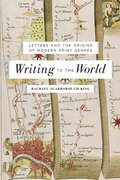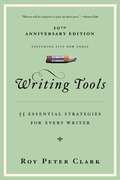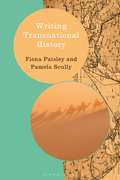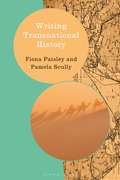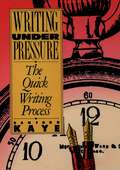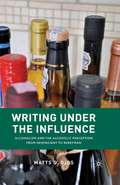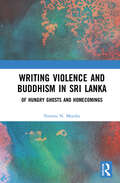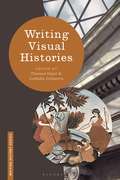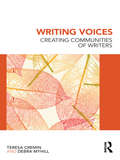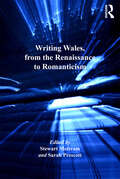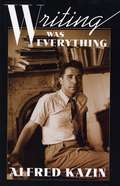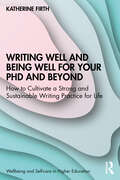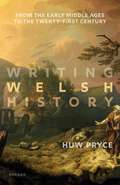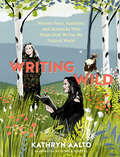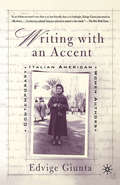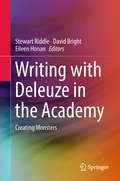- Table View
- List View
Writing to the World: Letters and the Origins of Modern Print Genres
by Rachael Scarborough KingIn Writing to the World, Rachael Scarborough King examines the shift from manuscript to print media culture in the long eighteenth century. She introduces the concept of the "bridge genre," which enables such change by transferring existing textual conventions to emerging modes of composition and circulation. She draws on this concept to reveal how four crucial genres that emerged during this time;¢;‚¬;€?the newspaper, the periodical, the novel, and the biography;¢;‚¬;€?were united by their reliance on letters to accustom readers to these new forms of print media.King explains that as newspapers, scientific journals, book reviews, and other new genres began to circulate widely, much of their form and content was borrowed from letters, allowing for easier access to these unfamiliar modes of printing and reading texts. Arguing that bridge genres encouraged people to see themselves as connected by networks of communication;¢;‚¬;€?as members of what they called "the world" of writing;¢;‚¬;€?King combines techniques of genre theory with archival research and literary interpretation, analyzing canonical works such as Addison and Steele;€™s Spectator, Samuel Johnson;€™s Lives of the Poets, and Jane Austen;€™s Northanger Abbey alongside anonymous periodicals and the letters of middle-class housewives. This original and groundbreaking work in media and literary history offers a model for the process of genre formation. Ultimately, Writing to the World is a sophisticated look at the intersection of print and the public sphere.
Writing Tools: 55 Essential Strategies for Every Writer
by Roy Peter ClarkA special 10th anniversary edition of Roy Peter Clark's bestselling guide to writing, featuring five bonus tools. Ten years ago, Roy Peter Clark, America's most influential writing teacher, whittled down almost thirty years of experience in journalism, writing, and teaching into a series of fifty short essays on different aspects of writing. In the past decade, Writing Tools has become a classic guidebook for novices and experts alike and remains one of the best loved books on writing available. Organized into four sections, "Nuts and Bolts," "Special Effects," "Blueprints for Stories," and "Useful Habits," Writing Tools is infused with more than 200 examples from journalism and literature. This new edition includes five brand new, never-before-shared tools. Accessible, entertaining, inspiring, and above all, useful for every type of writer, from high school student to novelist, Writing Tools is essential reading.
Writing Transnational History (Writing History)
by Fiona Paisley Pamela ScullyOver the past two decades, transnational history has become an established term describing approaches to the writing of world or global history that emphasise movement, dynamism and diversity. This book investigates the emergence of the 'transnational' as an approach, its limits, and parameters. It focuses particular attention on the contributions of postcolonial and feminist studies in reformulating transnational historiography as a move beyond the national to one focusing on oceans, the movement of people, and the contributions of the margins. It ends with a consideration of developing approaches such as translocalism. The book considers the new kinds of history that need to be written now that the transnational perspective has become widespread. Providing an accessible and engaging chronology of the field, it will be key reading for students of historiography and world history.
Writing Transnational History (Writing History)
by Fiona Paisley Pamela ScullyOver the past two decades, transnational history has become an established term describing approaches to the writing of world or global history that emphasise movement, dynamism and diversity. This book investigates the emergence of the 'transnational' as an approach, its limits, and parameters. It focuses particular attention on the contributions of postcolonial and feminist studies in reformulating transnational historiography as a move beyond the national to one focusing on oceans, the movement of people, and the contributions of the margins. It ends with a consideration of developing approaches such as translocalism. The book considers the new kinds of history that need to be written now that the transnational perspective has become widespread. Providing an accessible and engaging chronology of the field, it will be key reading for students of historiography and world history.
Writing Under Pressure: The Quick Writing Process
by Sanford KayeMost writing is done under pressure. An executive has to produce a three-page position paper by tomorrow at nine. A department head suddenly has to write a one-page action memo by noon. A graduate student has a twenty-page research paper due in a week. Yet, while most students and professionals write under pressure--with limited time, limited space, and a supervisor or instructor to please--few approach the task systematically. In Writing Under Pressure, Sanford Kaye, a renowned expert on the subject, presents a system he calls the Quick Writing Process (QWP) that focuses on real-world writing tasks and demonstrates how to produce the clearest, most honest, most powerful work possible under the constraints of time and space. A writing instructor with twenty-five years' experience teaching students and professionals in business and government, Kaye tells writers how to budget their time and how to use this time efficiently. Exploring particular writing situations in which QWP can be applied to make the most of what the writer knows, Kaye discusses the process of taking exams, focusing on how instructors select questions and evaluate essays. He also considers writing in business and government, featuring an insightful analysis of a memo written by Colonel Oliver North. This memo highlights one of the most important issues writers in business and government face: whether to write the truth as they see it or simply what their bosses want to hear. Presenting a wealth of such examples, Kaye reveals how to break through stifling organizational codes in order to write memos and position papers that count. While most guides to writing ignore the constraints of time and space, Writing Under Pressure tackles these problems head on, making it an essential reference for students, business professionals, government officials, or anyone else faced with a difficult writing assignment that has to be done now.
Writing Under Pressure: The Quick Writing Process
by Sanford KayeMost writing is done under pressure. An executive has to produce a three-page position paper by tomorrow at nine. A department head suddenly has to write a one-page action memo by noon. A graduate student has a twenty-page research paper due in a week. Yet, while most students and professionals write under pressure--with limited time, limited space, and a supervisor or instructor to please--few approach the task systematically. In Writing Under Pressure, Sanford Kaye, a renowned expert on the subject, presents a system he calls the Quick Writing Process (QWP) that focuses on real-world writing tasks and demonstrates how to produce the clearest, most honest, most powerful work possible under the constraints of time and space. A writing instructor with twenty-five years' experience teaching students and professionals in business and government, Kaye tells writers how to budget their time and how to use this time efficiently. Exploring particular writing situations in which QWP can be applied to make the most of what the writer knows, Kaye discusses the process of taking exams, focusing on how instructors select questions and evaluate essays. He also considers writing in business and government, featuring an insightful analysis of a memo written by Colonel Oliver North. This memo highlights one of the most important issues writers in business and government face: whether to write the truth as they see it or simply what their bosses want to hear. Presenting a wealth of such examples, Kaye reveals how to break through stifling organizational codes in order to write memos and position papers that count. While most guides to writing ignore the constraints of time and space, Writing Under Pressure tackles these problems head on, making it an essential reference for students, business professionals, government officials, or anyone else faced with a difficult writing assignment that has to be done now.
Writing Under the Influence: Alcoholism and the Alcoholic Perception from Hemingway to Berryman
by M. DjosThe book offers a socio-critical analysis of the alcoholic perception in the poetry and fiction of modern American alcoholic writers. Matts Djos focuses on primary indicators of alcohol addiction (fear, manipulation, anger, loneliness, and antic-social behavior) and their expression in modern American literature. After providing a general foundation for analysis of the psychological effects of the disease, this volume scrutinizes the work of Ernest Hemingway, John Berryman, E.A. Robinson, Hart Crane, Theodore Roetheke, Robert Lowell, John Steinbeck, and William Faulkner. The detail provides critical and in-depth perspective on the workings of the alcoholic mind.
Writing Violence and Buddhism in Sri Lanka: Of Hungry Ghosts and Homecomings
by Nimmi N. MenikeThis book examines the idea of violence in the context of religion and literature. It addresses the question of freedom and peace, and violence, with reference to the Buddhist nationalist discourse in Sri Lanka, against the backdrop of Shyam Selvadurai’s novel, The Hungry Ghosts. The book discusses love, compassion, emancipation, ethics and responsibility through the concepts of identity, deconstruction and decolonization to view religion as language or writing. With a blend of philosophical insights from Emmanuel Levinas, Jacques Derrida, Maurice Blanchot, and Mahatma Gandhi on ideas of being and the other, differences, nonviolence and forgiveness, it insists on the ethical exigency of reinventing Buddhism in Sri Lanka. Delving into some the central motifs of Selvadurai’s novel, suffering, desire, hate, and vengeance, it questions popular Sinhala Buddhist readings to argue for the promise of inclusive and diverse approaches towards various groups, linguistic communities, women, and homosexuality. This book will be useful for scholars and researchers of literature and languages, South Asian literature, literary criticism and theory, linguistics, cultural studies, philosophy, religion, Buddhist studies, diaspora studies, and Sri Lankan literature and sociology.
Writing Violence and Buddhism in Sri Lanka: Of Hungry Ghosts and Homecomings
by Nimmi N. MenikeThis book examines the idea of violence in the context of religion and literature. It addresses the question of freedom and peace, and violence, with reference to the Buddhist nationalist discourse in Sri Lanka, against the backdrop of Shyam Selvadurai’s novel, The Hungry Ghosts. The book discusses love, compassion, emancipation, ethics and responsibility through the concepts of identity, deconstruction and decolonization to view religion as language or writing. With a blend of philosophical insights from Emmanuel Levinas, Jacques Derrida, Maurice Blanchot, and Mahatma Gandhi on ideas of being and the other, differences, nonviolence and forgiveness, it insists on the ethical exigency of reinventing Buddhism in Sri Lanka. Delving into some the central motifs of Selvadurai’s novel, suffering, desire, hate, and vengeance, it questions popular Sinhala Buddhist readings to argue for the promise of inclusive and diverse approaches towards various groups, linguistic communities, women, and homosexuality. This book will be useful for scholars and researchers of literature and languages, South Asian literature, literary criticism and theory, linguistics, cultural studies, philosophy, religion, Buddhist studies, diaspora studies, and Sri Lankan literature and sociology.
Writing Visual Histories (Writing History)
by Florence Grant and Ludmilla JordanovaWhat can visual artifacts tell us about the past? How can we interpret them rigorously, weaving their formal and material qualities into rich social contexts to reach wider historical conclusions? Unfolding key historiographical and methodological issues, Writing Visual Histories equips students to answer these questions, showing visual analysis to be a key skill in historical research. A multifaceted structure makes this a practical guide for writing and reflecting on visual histories. A first section includes six case studies -- on topics ranging from medieval heraldry to Life magazine. These examples are followed by an exploration of essential concepts that inform historical thinking about visual matters, a treatment of disciplinary practices, and discussion of the practicalities (such as accessing museum collections and organising permissions) that scholars working with visual sources have to navigate. This book is an invaluable tool kit for opening up a historical understanding of visual phenomena and practices of looking, and for writing that takes an integrated approach to studies of the past.
Writing Visual Histories (Writing History)
What can visual artifacts tell us about the past? How can we interpret them rigorously, weaving their formal and material qualities into rich social contexts to reach wider historical conclusions? Unfolding key historiographical and methodological issues, Writing Visual Histories equips students to answer these questions, showing visual analysis to be a key skill in historical research. A multifaceted structure makes this a practical guide for writing and reflecting on visual histories. A first section includes six case studies -- on topics ranging from medieval heraldry to Life magazine. These examples are followed by an exploration of essential concepts that inform historical thinking about visual matters, a treatment of disciplinary practices, and discussion of the practicalities (such as accessing museum collections and organising permissions) that scholars working with visual sources have to navigate. This book is an invaluable tool kit for opening up a historical understanding of visual phenomena and practices of looking, and for writing that takes an integrated approach to studies of the past.
Writing Voices: Creating Communities of Writers
by Teresa Cremin Debra MyhillThe perspectives of children, teachers and professional writers are often absent in the pedagogy of writing. Highly Commended for the UKLA Academic Book Award 2013, Writing Voices: Creating Communities of Writers responds to such silent voices and offers a text which not only stretches across primary and secondary practice, but also gives expression to these voices, making a new and significant contribution to understanding what it means to be a writer. Drawing upon recent research projects undertaken by the authors and others in the international research community, this fascinating text considers the nature of composing and the experience of being a writer. In the process it: explores the role of talk, creativity, autonomy, metacognition, writing as design and the shaping influence of literature and other texts; examines young people’s composing processes and attitudes to writing; considers teachers’ identities as writers and what can be learnt when teachers engage reflectively in writing; shares a range of professional writers’ practices, processes and perspectives; gives prominence to examples of writing from children, teachers, student teachers and professional writers alongside their reflective commentaries. This thought-provoking text offers theoretical insights and practical directions for developing the teaching and learning of writing. It is an invaluable read for all teachers and trainees, as well as teacher educators, researchers and anyone with an interest in the pedagogy of writing.
Writing Voices: Creating Communities of Writers
by Teresa Cremin Debra MyhillThe perspectives of children, teachers and professional writers are often absent in the pedagogy of writing. Highly Commended for the UKLA Academic Book Award 2013, Writing Voices: Creating Communities of Writers responds to such silent voices and offers a text which not only stretches across primary and secondary practice, but also gives expression to these voices, making a new and significant contribution to understanding what it means to be a writer. Drawing upon recent research projects undertaken by the authors and others in the international research community, this fascinating text considers the nature of composing and the experience of being a writer. In the process it: explores the role of talk, creativity, autonomy, metacognition, writing as design and the shaping influence of literature and other texts; examines young people’s composing processes and attitudes to writing; considers teachers’ identities as writers and what can be learnt when teachers engage reflectively in writing; shares a range of professional writers’ practices, processes and perspectives; gives prominence to examples of writing from children, teachers, student teachers and professional writers alongside their reflective commentaries. This thought-provoking text offers theoretical insights and practical directions for developing the teaching and learning of writing. It is an invaluable read for all teachers and trainees, as well as teacher educators, researchers and anyone with an interest in the pedagogy of writing.
Writing Wales, from the Renaissance to Romanticism
by Stewart MottramWriting Wales explores representations of Wales in English and Welsh literatures written across a broad sweep of history, from the union of Wales with England in 1536 to the beginnings of its industrialization at the turn of the nineteenth century. The collection offers a timely contribution to the current devolutionary energies that are transforming the study of British literatures today, and it builds on recent work on Wales in Renaissance, eighteenth-century, and Romantic literary studies. What is unique about Writing Wales is that it cuts across these period divisions to enable readers for the first time to chart the development of literary treatments of Wales across three of the most tumultuous centuries in the history of British state-formation. Writing Wales explores how these period divisions have helped shape scholarly treatments of Wales, and it asks if we should continue to reinforce such period divisions, or else reconfigure our approach to Wales' literary past. The essays collected here reflect the full 300-year time span of the volume and explore writers canonical and non-canonical alike: George Peele, Michael Drayton, Henry Vaughan, Katherine Philips, and John Dyer here feature alongside other lesser-known authors. The collection showcases the wide variety of literary representations of Wales, and it explores relationships between the perception of Wales in literature and the realities of its role on the British political stage.
Writing Wales, from the Renaissance to Romanticism
by Stewart MottramWriting Wales explores representations of Wales in English and Welsh literatures written across a broad sweep of history, from the union of Wales with England in 1536 to the beginnings of its industrialization at the turn of the nineteenth century. The collection offers a timely contribution to the current devolutionary energies that are transforming the study of British literatures today, and it builds on recent work on Wales in Renaissance, eighteenth-century, and Romantic literary studies. What is unique about Writing Wales is that it cuts across these period divisions to enable readers for the first time to chart the development of literary treatments of Wales across three of the most tumultuous centuries in the history of British state-formation. Writing Wales explores how these period divisions have helped shape scholarly treatments of Wales, and it asks if we should continue to reinforce such period divisions, or else reconfigure our approach to Wales' literary past. The essays collected here reflect the full 300-year time span of the volume and explore writers canonical and non-canonical alike: George Peele, Michael Drayton, Henry Vaughan, Katherine Philips, and John Dyer here feature alongside other lesser-known authors. The collection showcases the wide variety of literary representations of Wales, and it explores relationships between the perception of Wales in literature and the realities of its role on the British political stage.
Writing Was Everything (The William E. Massey Sr. Lectures In The History Of American Civilization Ser. #Vol. 1994)
by Alfred KazinA deft blend of autobiography, history, and criticism, Writing Was Everything emerges as a reaffirmation of literature in an age of deconstruction and critical dogma. It stands as clear testimony to Kazin's belief that "literature is not theory but, at best, the value we can give to our experience, which in our century has been and remains beyond the imagination of mankind."
Writing Was Everything (The William E. Massey Sr. Lectures In The History Of American Civilization Ser.)
by Alfred KazinA deft blend of autobiography, history, and criticism, Writing Was Everything emerges as a reaffirmation of literature in an age of deconstruction and critical dogma. It stands as clear testimony to Kazin's belief that "literature is not theory but, at best, the value we can give to our experience, which in our century has been and remains beyond the imagination of mankind."
Writing Well: Creative Writing and Mental Health (PDF)
by Deborah Philips Debra Penman Liz LinningtonWriting Well is a practical handbook of creative writing exercises which forms the basis of an indirect, nonconfrontational approach specifically intended for therapeutic use within the mental health field. The exercises are taken from the authors' successful practice with groups of people from a range of backgrounds in a variety of settings.
Writing Well and Being Well for Your PhD and Beyond: How to Cultivate a Strong and Sustainable Writing Practice for Life (Wellbeing and Self-care in Higher Education)
by Katherine FirthPrioritizing wellbeing alongside academic development, this book provides practical advice to help students write well, and be well, during their PhD and throughout their career. In this unique book, Katherine Firth offers expert guidance on developing a writing practice and avoiding burnout, providing strategies and insights for developing a sustainable writing career beyond the PhD thesis. The book covers every stage of the academic writing process, from planning and researching, through getting words on the page, to the often unexpectedly time-consuming editing and polishing. Readers are reminded that writing a thesis is hard work, but it needn’t be damaging work. Each chapter includes a toolbox of strategies and techniques, such as meditations, writing exercises and tips to maintain physical wellbeing, that will help doctoral candidates start writing and keep writing, without sacrificing their health, wellbeing or relationships. Relevant at any stage of the writing process, this book will help doctoral students and early career researchers to produce great words that people want to read, examiners want to pass and editors want to publish.
Writing Well and Being Well for Your PhD and Beyond: How to Cultivate a Strong and Sustainable Writing Practice for Life (Wellbeing and Self-care in Higher Education)
by Katherine FirthPrioritizing wellbeing alongside academic development, this book provides practical advice to help students write well, and be well, during their PhD and throughout their career. In this unique book, Katherine Firth offers expert guidance on developing a writing practice and avoiding burnout, providing strategies and insights for developing a sustainable writing career beyond the PhD thesis. The book covers every stage of the academic writing process, from planning and researching, through getting words on the page, to the often unexpectedly time-consuming editing and polishing. Readers are reminded that writing a thesis is hard work, but it needn’t be damaging work. Each chapter includes a toolbox of strategies and techniques, such as meditations, writing exercises and tips to maintain physical wellbeing, that will help doctoral candidates start writing and keep writing, without sacrificing their health, wellbeing or relationships. Relevant at any stage of the writing process, this book will help doctoral students and early career researchers to produce great words that people want to read, examiners want to pass and editors want to publish.
Writing Welsh History: From the Early Middle Ages to the Twenty-First Century
by Huw PryceWriting Welsh History is the first book to explore how the history of Wales and the Welsh has been written over the past fifteen hundred years. By analysing and contextualizing a wide range of historical writing, from Gildas in the sixth century to recent global approaches, it opens new perspectives both on the history of Wales and on understandings of Wales and the Welsh - and thus on the use of the past to articulate national and other identities. The study's broad chronological scope serves to highlight important continuities in interpretations of Welsh history. One enduring preoccupation is Wales's place in Britain. Down to the twentieth century it was widely held that the Welsh were an ancient people descended from the original inhabitants of Britain whose history in its fullest sense ended with Edward I's conquest of Wales in 1282-4, their history thereafter being regarded as an attenuated appendix. However, Huw Pryce shows that such master narratives, based on medieval sources and focused primarily on the period down to 1282, were part of a much larger and more varied historiographical landscape. Over the past century the thematic and chronological range of Welsh history writing has expanded significantly, notably in the unprecedented attention given to the modern period, reflecting broader trends in an increasingly internationalized historical profession as well as the influence of social, economic, and political developments in Wales and elsewhere.
Writing Welsh History: From the Early Middle Ages to the Twenty-First Century
by Huw PryceWriting Welsh History is the first book to explore how the history of Wales and the Welsh has been written over the past fifteen hundred years. By analysing and contextualizing a wide range of historical writing, from Gildas in the sixth century to recent global approaches, it opens new perspectives both on the history of Wales and on understandings of Wales and the Welsh - and thus on the use of the past to articulate national and other identities. The study's broad chronological scope serves to highlight important continuities in interpretations of Welsh history. One enduring preoccupation is Wales's place in Britain. Down to the twentieth century it was widely held that the Welsh were an ancient people descended from the original inhabitants of Britain whose history in its fullest sense ended with Edward I's conquest of Wales in 1282-4, their history thereafter being regarded as an attenuated appendix. However, Huw Pryce shows that such master narratives, based on medieval sources and focused primarily on the period down to 1282, were part of a much larger and more varied historiographical landscape. Over the past century the thematic and chronological range of Welsh history writing has expanded significantly, notably in the unprecedented attention given to the modern period, reflecting broader trends in an increasingly internationalized historical profession as well as the influence of social, economic, and political developments in Wales and elsewhere.
Writing Wild: Women Poets, Ramblers, and Mavericks Who Shape How We See the Natural World
by Kathryn AaltoWriting Wild, by New York Times-bestselling author Kathryn Aalto, explores the lasting impact of 25 women writers whose pens have left an indelible mark on the world of nature writing.
Writing With An Accent: Contemporary Italian American Women Authors
by Edvige GiuntaMary Cappello, Louise DeSalvo, Sandra M. Gilbert, Maria Mazziotti Gillan, Carole Maso, Agnes Rossi. These are some of the best-known Italian American writers today. They are part of a literary tradition with mid-twentieth century roots that began to develop, in earnest, in the late 1970s and early 1980s. During those decades, a number of Italian American women, such as Helen Barolini, began to publish books that depicted their perspectives on life through the critical lenses of gender, class, and ethnicity. At the end of the twentieth century, this literature finally blossomed into a fully fledged cultural movement that also took into account issues of sexuality, age, illness, and familial and societal abuse. Writing with an Accent takes a look at this vibrant literary movement by discussing those first writers of the 1970s and 1980s as well as later authors. At the center of Edvige Giunta s Writing with an Accent is the literal notion of accent, the marker of linguistic and cultural difference that separates and identifies recent immigrants to the United States. In this study, an accent symbolically embodies the differences and creative strategies through which contemporary Italian American women writers engage Italian American culture in works of fiction, poetry, and memoir. Giunta also looks at the links between the literature and art, music, film, and video produced by contemporary Italian American women. The literature of the Italian American women in Writing with an Accent is shaped by the complicated connections these authors maintain with their cultural origins, but also, and perhaps more importantly, by their feminist consciousness and politicized sense of ethnic identity. Writing with an Accent celebrates and explores a group of authors who characteristically mix the joy and pain of Italian American life to paint a multifaceted picture of Italian American women and their complex place in U.S. culture.
Writing with Deleuze in the Academy: Creating Monsters
by Stewart Riddle David Bright Eileen HonanIn this book, authors working with Deleuzean theories in educational research in Australia and the United Kingdom grapple with how the academic-writing machine might become less contained and bounded, and instead be used to free impulses to generate different creations and connections. The authors experiment with forms of writing that challenge the boundaries of academic language, moving beyond the strictures of the scientific method that governs and controls what works and what counts to make language vibrate with a new intensity.The authors construct monstrous creations, full of vitality and fervor, hybrid texts, part academic part creative assemblages, almost-but-perhaps-not-quite recognisable as research. Stories that blur the lines between true and untrue, re-presentation and invention.The contributors to this book hope that something might happen in its reading; that some new connections might be made, but also acknowledge the contingency of the encounter between text and reader, and the impossibility of presuming to know what may be.
